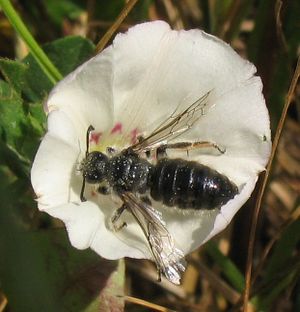Flat tooth spiral horn bee
| Flat tooth spiral horn bee | ||||||||||||
|---|---|---|---|---|---|---|---|---|---|---|---|---|

Flat tooth spiral horn bee ( Systropha planidens ) |
||||||||||||
| Systematics | ||||||||||||
|
||||||||||||
| Scientific name | ||||||||||||
| Systropha planidens | ||||||||||||
| Giraud , 1861 |
The flat-tooth spiral horn bee ( Systropha planidens ) is a species of bee from the Halictidae family and the genus of the spiral horn bees ( Systropha ).
features
The species is black in color with sparse gray hairs, only the abdomen gites of the females are densely hairy on the sides. With a size of 1 cm or more, it is slightly larger than Systropha curvicornis , the other Central European species of spiral horn bees. Further differences in the female are the completely gray-brown haired abdomen and the not significantly elongated second segment of the antennae flagella. The male has on the second abdominal segment on each side a large tooth, flattened at the tip, to which the name of the species refers ( planus : flat, dens : tooth). The seventh back segment is elongated and not cut out.
distribution
Systropha planidens forms two subspecies, the distribution area of the nominate form ranges from Germany to the southern Urals , including the Balkans and Greece , where it occurs very frequently. The western subspecies Systropha planidens grandimargo lives in Spain and southern France. In Germany it occurs only in the south, at a few locations in Rhineland-Palatinate , Baden-Württemberg , Hesse and Bavaria . The northernmost location is near Frankfurt (Großkarben). This species is absent in eastern Germany and only occurs again in eastern Poland.
Way of life
The species specializes in the flowers of bindweed as a source of pollen (oligolectic). The main source of pollen in Central Europe is the bindweed . It nests in self-dug burrows. The nest consists of a main passage, which reaches a depth of 50 centimeters, and short side passages, each with a brood cell; five to eight cells in total. After completion, provisioning and laying of eggs, the side passage is filled with earth. The species often nests gregariously. The flight time ranges from mid-June to late July, with the males appearing clearly (about two weeks) before the females. There is only one generation a year. The larva is the overwintering stage.
The cuckoo bee Biastes brevicornis lives in the species .
habitat
In Central Europe, Systropha planidens can only be found in warm areas, but in contrast to Systropha curvicornis it does not require any larger vegetation-free areas; an unpaved field path is often sufficient to make the nest. The nests are usually created on the side of the path or in embankments in compacted soil. Larger, stable populations can only develop where fields and vineyards are criss-crossed by a network of unpaved roads and where bindweed grows in sufficient quantities as a source of pollen. The main threat to this species in Germany is the intensification of agriculture with asphalting roads and the use of herbicides.
swell
- Paul Westrich : The wild bees of Baden-Württemberg. 2 volumes. Eugen Ulmer Verlag 1989/1990.